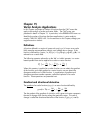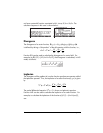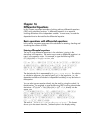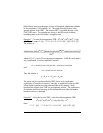
Page 16-1
Chapter 16
Differential Equations
In this Chapter we present examples of solving ordinary differential equations
(ODE) using calculator functions. A differential equation is an equation
involving derivatives of the independent variable. In most cases, we seek the
dependent function that satisfies the differential equation.
Basic operations with differential equations
In this section we present some uses of the calculator for entering, checking and
visualizing the solution of ODEs.
Entering differential equations
The key to using differential equations in the calculator is typing in the
derivatives in the equation. The easiest way to enter a differential equation is to
type it in the equation writer. For example, to type the following ODE:
(x-1)⋅(dy(x)/dx)
2
+ 2⋅x⋅y(x) = e
x
sin x, use:
‚O „ Ü~ „x -1 ™™™*‚¿ ~„x
™~„y„Ü~„x™™ Q2 ™™+2*
~„ x * ~„ y „Ü~„x ™™™™
‚= „¸ ~„ x ™*S~„x `
The derivative dy/dx is represented by ∂
x(y(x)) or by d1y(x). For solution
or calculation purposes, you need to specify y(x) in the expression, i.e., the
dependent variable must include its independent variable(s) in any derivative in
the equation.
You can also type an equation directly into the stack by using the symbol ∂ in
the derivatives. For example, to type the following ODE involving second-order
derivatives: d
2
u(x)/dx
2
+ 3u(x)⋅(du(x)/dx) + u(x)
2
= 1/x, directly into the
screen, use:
³‚∂ ~„x„Ü‚¿~„x„ Ü~ „u
„Ü ~„x™™™+3*~ „u„Ü
~„x™*‚¿~„x„ Ü~„u„ Ü
~„x ™™ +~„u„ Ü ~„x™ Q2
‚ Å 1/ ~„x`
The result is ‘∂
x(∂x(u(x)))+3*u(x)*∂x(u(x))+u^2=1/x ’. This format
shows up in the screen when the _Textbook option in the display setting


















